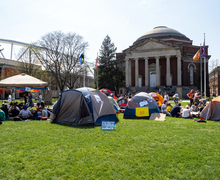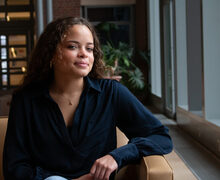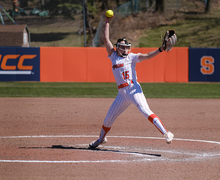SU undergrads struggle to access grocery stores, pharmacies, survey finds
Cindy Zhang | Digital Design Director
Isabela Couoh, a senior design studies major in the College of Visual and Performing Arts, designed a survey for her capstone project that indicated students at Syracuse University struggle to access personal need items from grocery stores and pharmacies on campus.
Get the latest Syracuse news delivered right to your inbox.
Subscribe to our newsletter here.
Just under half of Syracuse University undergraduate respondents said it is difficult to access personal need items found at pharmacies or grocery stores from campus, a recent student survey found.
The survey, which accepted responses from Feb. 18 to March 17, had 516 responses — around 3.5% of SU’s approximately 15,000 undergraduate student population. Respondents also expressed similar levels of difficulty accessing the city of Syracuse and local entertainment, including museums and events.
Isabela Couoh, a senior design studies major in the College of Visual and Performing Arts, designed the survey for her capstone project. The design studies capstone is aimed at demonstrating students’ “proficiency as design researchers,” Couoh’s faculty capstone mentor, assistant professor Jody Nyboer, wrote in a statement to The Daily Orange.
“About 47% of students said that they had a difficult or very difficult time accessing (grocery stores and pharmacies), which is a huge number,” Couoh said. “Half of the people that I surveyed said that they were having issues getting food and medicine — that’s huge.”
The majority of respondents said walking and Centro buses are their primary transportation methods to get to and around campus, Couoh said. Off-campus transportation methods were most commonly personal vehicles, including cars and bikes, and ride-share services, like Uber and Lyft.
Respondents reported “gaps in scheduling” as the primary issue with on and off-campus transportation, such as Centro buses and ‘Cuse Trolleys, Couoh said. Students also took issue with off-campus public transportation, including the lack of transportation to “desired destinations” such as Erie Boulevard East and Destiny USA mall, as well as bus stop locations near Brewster, Boland and Brockway halls, she said.
Couoh said other respondents cited a lack of diverse and affordable grocery store options near campus. There is currently a CVS near campus on South Crouse Avenue and a Walgreens and a Tops Friendly Markets near South Campus off of East Colvin Street. There are also on-campus convenience stores available, including the Campus Store Market in Schine Student Center, FoodWorks in the lower level of Graham Dining Center, Skytop Marketplace in Goldstein Student Center and the West Campus Market, according to SU’s website.
Couoh, who Nyboer said is part of the design studies program’s third cohort of graduating seniors, takes classes at SU’s Nancy Cantor Warehouse, which she said she and her classmates struggle to access. She said she designed the “How do you get around SU?” survey to learn about other students’ experiences with on- and off-campus transportation, an issue she wanted on the community’s radar.
“It really started from that, just having to take classes (at the Warehouse) and hearing that a lot of other students were also struggling with getting to and from their classes,” Couoh said. “It started off as a personal issue and I was like, ‘Well, let’s do something about it on a school-wide level.’”
After initial planning in her design research class and inspiration from the concept of Bus Rapid Transit, as well as other studies on the topic, she began to look for funding options. She discovered the Syracuse Office of Undergraduate Research & Creative Engagement, or the SOURCE, while studying at Bird Library, where the office was formerly housed before relocating to Bowne Hall.
The SOURCE, funded by an annual $1 million commitment from the university, supports undergraduate student research through programs like the recent Spring Showcase, according to its website. Couoh recently presented her initial capstone findings from the survey in a presentation through the SOURCE, she said.
“The SOURCE can help student(s) at any point in their research journey – from just talking about what research and creative activity typically involves in their major, to helping a student find a faculty mentor or (helping) more advanced students meet their goals with funding support,” the office’s director, Kate Hanson, wrote in a statement to The D.O.
Couoh applied for a grant from the SOURCE and submitted her capstone proposal in October 2023. In December, Couoh was awarded the grant. The bulk of the grant money went toward incentives for the survey, including food, Couoh said. She said she tabled for over 19 hours in Schine in addition to hanging posters around campus.
A majority of survey respondents were students in the College of Arts and Sciences and the Newhouse School of Public Communications, Couoh said. There were over 100 student respondents per class, she said, except for third-year students, whose lack of participation she attributed to students studying abroad.
“My next step is combing through this data, figuring out the findings and then sitting down and doing some research,” Couoh said. “Based on the criteria that we have established from this data, what kind of solutions would be viable for the university on a large scale?”
Couoh said she will use case studies, comparing SU’s available transportation and campus layout to other universities and cities, to write a comparative report. She plans to submit the report to SU’s Parking and Transportation Services, city transportation organizations and student groups like the Student Association.
Nyboer wrote that Couoh’s project will most likely “not be fully realized by the time she graduates” given the large population she measured in the month-long span of the survey. The design studies capstone values “working on small bites out of big issues,” and Couoh said she plans to have clear findings to present.
Couoh will host a “community symposium” to present her findings to the SU community on April 11th from 11 a.m. to 2 p.m. in 115 Smith Hall.
“The most important thing about research is that it continues,” Couoh said. “Hopefully I can pass this on to someone else after we start implementing some changes.”
CLARIFICATION: A previous version of this article listed Fulbright Day and Lender Center Fellow Symposium as examples of events supported by The SOURCE. The SOURCE promoted these events, but these events were hosted by other organizations.
Published on April 2, 2024 at 12:05 am
Contact Griffin: gbrown19@syr.edu





